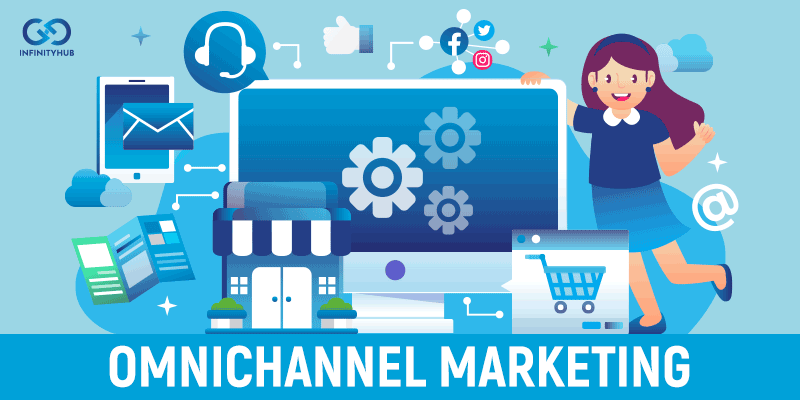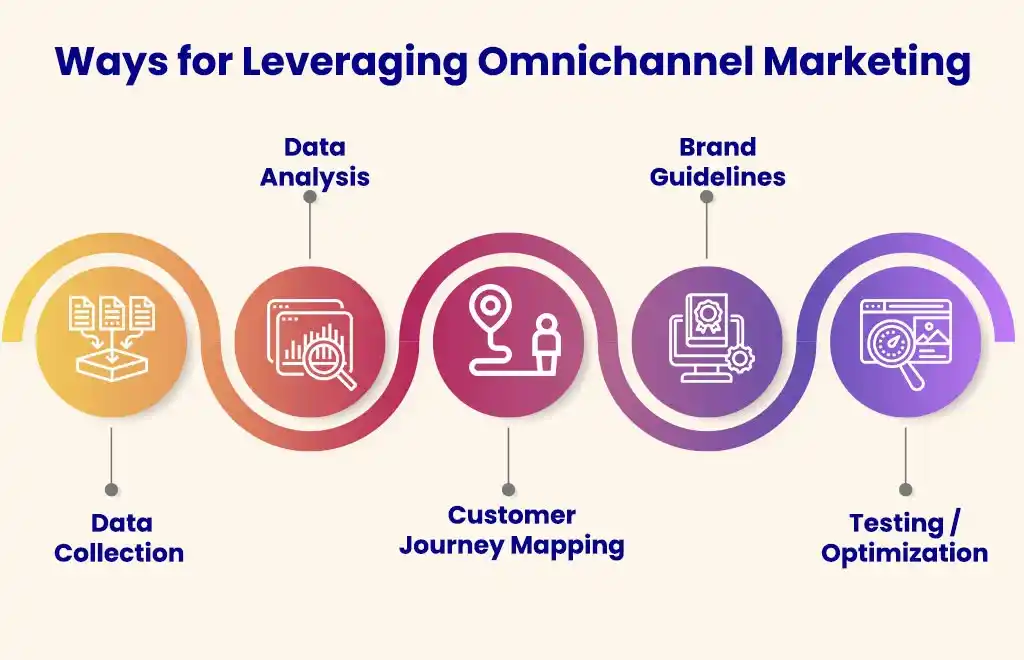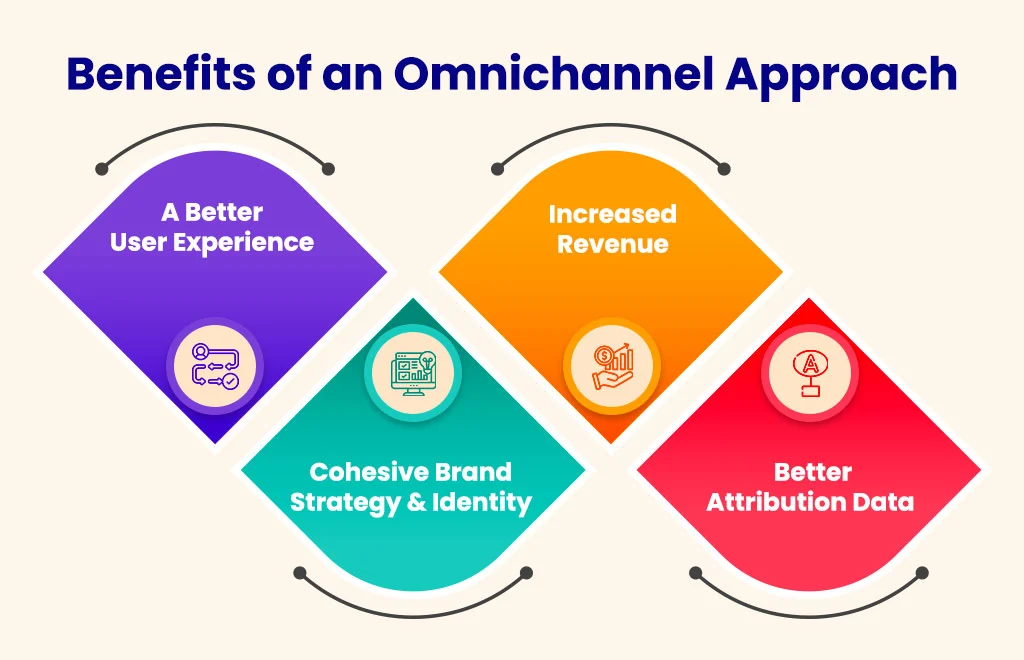Whether walking into a store or scrolling on a mobile app, shopping is a unique experience for everyone. When was the last time you made a purchase? What sparked it? Did you see a commercial ad? Marketing is part of everything you do. Every brand interaction and your way of purchasing play a vital role in buying an item. So, how can brands ensure they reach customers at each stage? The solution is an Omnichannel Marketing. An Omnichannel Marketing statistic can help you seamlessly integrate all channels. By understanding how your customers shop, you can take a customer-centric approach to connecting with users on different channels as they move towards a purchase. With even more updated technology and unique shopping experience opportunities, buyers expect more from brands. Before we go any further, let’s break down what Omnichannel Marketing is. Is it absolutely essential? You will know everything from this blog.
The word Omnichannel comes from the Latin Omnis, meaning every/all, and Channel, which describes all the ways you interact with a brand. So, Omnichannel essentially means every channel. For instance, your mobile device is a channel, as is your computer, websites, apps, etc. It allows consumers to seamlessly interact with the brand across different platforms, enhancing their general brand experience.
Omnichannel Marketing and Multichannel Marketing are different concepts based on engaging consumers across multiple platforms. Omnichannel considers that the customer journey may transit multiple channels and looks at how to create the best experience as consumers move between them. Alternatively, Multichannel glances at the specific channel and how the marketing will be completed there. Each interaction is an Omnichannel attribution, leading to a conversion. Let’s take a look at the Multichannel vs. Omnichannel Marketing:
Multichannel Marketing is more straightforward in its purpose: to broadcast content and advertisements across different channels. A Multichannel strategy makes an organization open to consumers online. The consumer can choose where to interact with the brand. However, content and engagements within these channels often must be more varied. With this in mind, Multichannel is more thoughtful of operations, reaching as many relevant channels as possible, while Omnichannel reflects the overall customer experience.
Omnichannel Marketing also makes brands obtainable across online and offline channels. However, it further assures an integrated, seamless experience across each. As consumers move across devices and online and offline platforms, transitions are seamless and prior encounters inform messages. An Omnichannel approach allows organizations to take a consumer-centric system that keeps the comprehensive customer journey in mind.
In a world with multiple touchpoints across channels, which should get credit for the conversion? That can be hard for marketers to answer without a suitable Omnichannel Attribution Model. Marketers often rely on Multi-Touch Attribution and Media Mix Modelling (MMM) to understand what led to a conversion. However, these models are not perfect.
Media Mix Modeling only looks at long-term aggregate data rather than person-level insights. While this allows marketers to see a campaign’s impact on conversions and historical trends, such as times of year when shoppers increase or decrease engagements, it does not provide insight into individual preferences. MMM also uses several years of data, meaning teams cannot use this model to optimize real-time campaigns.
Multi-Touch Attribution offers real-time granular, person-level data across each touchpoint. When analyzed, teams can use this data to change campaigns as they run to better cater to consumer needs. The Multi-Touch Attribution challenge is that deciding how much credit each touchpoint should be given for conversion is complicated.
Omnichannel Attribution models no longer rely on outdated practices and can give a more holistic view of the marketing funnel and the buyer’s journey. As Omnichannel Marketing statistics combine online and offline channels, Omnichannel attribution removes silos between campaign measurements to understand each touchpoint’s role in the journey.
Leveraging Omnichannel attribution offers various benefits to brands, allowing them to correlate online and offline measurements, gain visibility into person-level insights and aggregate historical shopper trends.
Creating an Omnichannel experience requires understanding how the users interact with your brand. It focuses on the channel and the experience as a whole. With this in mind, there are a few needs when it comes to making an Omnichannel Marketing statistics experience:
Collecting accurate and timely data about your buyers is essential to implementing an Omnichannel strategy approach. This data will allow you to understand what your target audience prefers to interact with brands and on which devices, which type of conversations they are more likely to engage with, what products and features they are looking for, etc. This data will be the enterprising information behind an Omnichannel attribution. Brands must ensure they have the tools to collect this data effectively across online and offline channels. Unified Marketing Measurement (UMM) is an intelligent way to do this. This Omnichannel attribution model combines the individual-level metrics of Multi-Touch Attribution with the historic, aggregate measurements of Media Mix Modeling. This way, touchpoints can be informed by individual preferences and historical trends, such as regional or seasonal elements that affect engagements/conversions.
Data Collection of users is only the first step. It is useless without a team and platform that can translate all of this big data into Omnichannel Approach insights. Brands need to release an analytics platform that can distill all this data in near real-time so that teams can course-correct while campaigns run to meet consumer needs.
3. Customer Journey Mapping
Organizations need to develop a brand identity with clear guidelines for messaging and creativity. These guidelines should be attached across each channel to facilitate brand awareness and recognition. Another way organizations can help promote an Omnichannel Attribution is by leveraging brand tracking tools that can help measure and predict their brand’s health in the consumer’s mind.
5. Testing / Optimization
One of the most critical components of Omnichannel Marketing statistics is continuously testing your Omnichannel approach’s efficacy. It allows the marketing team to specify ways to optimize Omnichannel approach campaign spend, messaging, creativity, and more. Today’s organizations should utilize media planning tools like budget, multiple KPIs, target audience, and media mix into consideration and, in turn, provide an excellent media plan that can maximize ROI (Return On Investment) and report future decision-making.
Now that you’re more familiar with Multichannel Vs. Omnichannel Marketing, it’s essential to consider a few key trends in Omnichannel Marketing statistics:
Buyers are shopping online and offline: Shoppers value having both options, so incorporating both online and offline channels ensures you can reach relevant audiences.
AI-enabled chatbots are becoming more popular: These intelligent, human-like bots can help with easy and complicated tasks. They even affect human speech to feel more relatable while helping customers.
More Omnichannel approach channels can mean more engagement. If more Omnichannel attribution can lead to more engagement, and if more engagement can lead to higher purchase and retention rates, it’s time to start building even more channels under your Omnichannel Marketing statistics.
Today, most brands will decide that an Omnichannel Approach can produce the best results. While executing an Omnichannel Approach is far from simple, it offers many benefits when done correctly. Today’s consumers are used to being flooded with messaging from various brands, and as a result, they have become more selective of which brands they select to engage with. Creating an Omnichannel Approach can bring the following benefits:
Since the Omnichannel Approach focuses on every user experience across devices instead of the channel, the customer experience (CX) will improve by focusing on the customer instead of the platform. In this way, companies can drive more sales and better retention rates.
Cohesive Brand Strategy & Identity
Making seamless Omnichannel Marketing statistics across channels means building an identifiable brand image and tone. Organizations should establish this image on core user needs and values. By concentrating on the overall experience and working within brand policies to target each channel, we will have a complete brand strategy that will transform into increased loyalty and targeted messaging.
An Omnichannel Approach encourages users to engage with a brand across multiple channels. These increased engagements at each stage of the buyer’s path can help to increase revenue, as research shows that customers who engage with Omnichannel attributes tend to be 30% more valuable. This more targeted messaging also builds brand loyalty, making customers more likely to purchase from your brand again. Repeat customers, on average, contribute to 40% of revenue despite a smaller portion of your consumer base.
Omnichannel Marketing statistics should extend to a user’s experience with your brand and your data analytics. By tracking engagements across channels, brands better understand the customer journey, when and where consumers prefer to engage, and which campaigns have created the most value. All this data can be added to your Omnichannel Approach to build more targeted campaigns and optimize media spending.
Omnichannel attribution has become popular among industries as consumers become more empowered. However, they are especially noticeable in these verticals:
Retail, in particular, has encountered extreme changes in today’s Omnichannel approach environment. With the ability to buy in-store or online and the emergence of social media and review sites, retail marketers need to centralize how consumers interact with their brands across many channels to ensure a positive outcome.
Healthcare users interact with many touchpoints across diverse providers, from hospitals to primary care to pharmaceuticals. By analyzing data around the customer journey and engagements, healthcare providers can better care for individuals, equipping them with data that matters most to them while mitigating possible health risks.
Since cars are a long-term investment, keeping them in mind and driving buyer loyalty are big priorities for car dealerships and manufacturers. Today’s ads may not yield the desired effects immediately, but if they engage current customers and interest prospects, they will impact sales. However, the buying journey, even in automotive, has changed, with 80 per cent of shoppers researching cars online first. An encompassing Omnichannel Marketing statistics that engage with buyers across all touchpoints has become more vital than ever.
The banking and financial services industry is shifting from a product-obsessed mindset to a more customer-centric view. As they do so, organizations must consider how they can deliver personalized experiences to gain insight into which services and products would best fit each user based on their wants, preferences, and needs.





 India
India USA
USA


